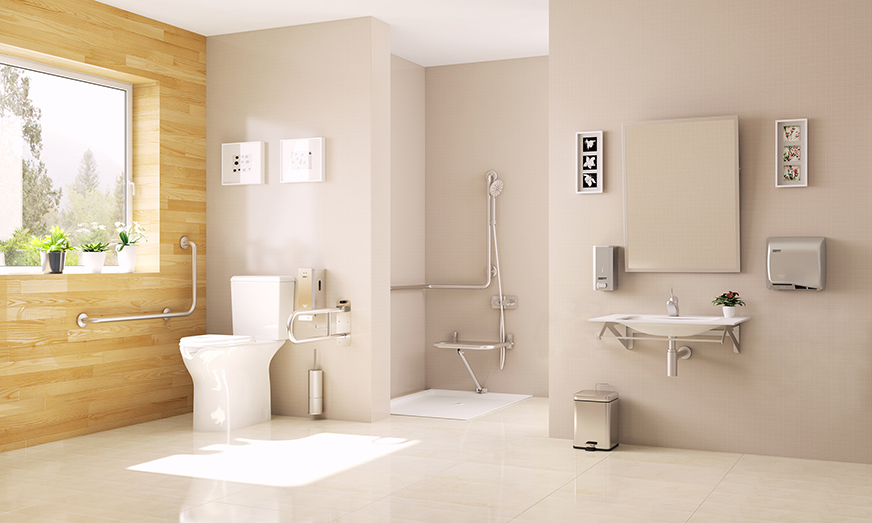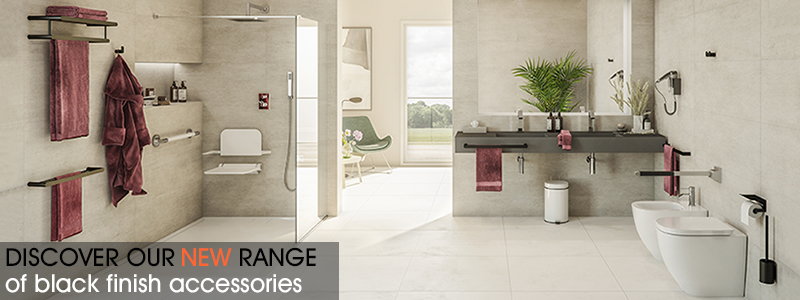Accessible and inclusive public toilets. The great pending subject.
"That is no country for old men". Thus begins the poem Sailing to Byzantium by William Butler Yeats, which inspired the novel by the great American writer Cormac McCarthy and was later brought to the big screen by the Coen brothers, winning four Oscar statuettes, including Javier Bardem's for best supporting actor in 2008.
Following with the Yeats analogy, various studies show that our cities are not designed for the elderly or for those with some kind of disability. At present, more than 25% of the world population is made up of people of advanced age and/or with some type of disability. More than half of this group lives in cities and it is estimated that by the year 2050 this number will come to represent more than 2 billion people. Generally speaking, all these people experience some kind of barrier that prevents their active participation within the cities. These barriers limit their full inclusion and integration in our society, as they cause them many difficulties in accessing basic services such as transportation for effective mobility, in accessing public spaces or they also have serious difficulties in accessing their own employment and/or education.
Specifically, a study carried out by C4All (Cities for All) entitled "The inclusion imperative: towards disability-inclusive and accessible urban development", shows that 80% of people with disabilities who live in developing countries face considerable discrimination and barriers that prevent them from participating in society on equal terms with the rest of the population.
This is where universal accessibility comes into play, understood in its broadest sense of the word and as the backbone of all public and private policies on disability at a global level. This is so because universal accessibility is part of the exercise of normalization of human rights as fundamental as freedom of movement, freedom of communication or freedom of expression, to name but a few. In other words, accessibility is a question of civil rights, so its absence is considered a flagrant violation of these rights, a violation of the law, unequal and discriminatory treatment and, therefore, can be prosecuted and punished.
But let's take one step at a time and define this concept of universal accessibility. Universal accessibility is the characteristic that environments, goods, products and services must meet, which allows all people to access, understand, use and enjoy them in a standardized, comfortable, safe and efficient manner. In other words, spaces, products and services are considered accessible if they conform to the functional and dimensional requirements that guarantee their autonomous and comfortable use for people with reduced mobility or any other limitation.
Therefore, accessibility tries to find a way that all people, regardless of their abilities, can enjoy the environment that surrounds them in the simplest possible way and without any hindrance. Accessibility must always be synonymous with quality of life and safety.

One of the places where the concept of universal accessibility must necessarily be present is in the public toilet. People with mobility, sensory or cognitive problems must be able to access and use the bathroom without any type of problem or impediment. To this end, it is necessary that certain requirements regarding the space and the location of those objects to be used are met.
The first requirement to take into account is the availability and signage of this type of bathroom. If we talk about something being "accessible", we are implicitly emphasizing the normalization of a certain situation. Therefore, an accessible bathroom must be integrated into the bathrooms oriented to both sexes. Placing a separate bathroom, intended solely and exclusively for people with disabilities is not recommended
On the other hand, an accessible bathroom must be marked with the international symbol of accessibility (SIA) accompanied by the male, female or family icons depending on their type. You can add the word "Bathroom" that identifies the enclosure and no terms will be added that indicate the condition of the people who use it as "disabled" or others.
The distribution of all the elements that make up the bathroom will obviously depend on the space available and is another requirement to take into account when designing an accessible public bathroom. The larger this space, the better the mobility and functionality of users with disabilities inside. This space, at least, must allow a 1,5m diameter turn of a conventional wheelchair and must be free of obstacles.

Amongst these elements that constitute the bathroom for people with disabilities, we find the grab bars and technical aids. The grab bars are essential elements that facilitate mobility and use of the bathroom and their installation is mandatory. These should be easy to grip, have a circular section with a diameter of 30-40mm, allow a separation from the wall of between 45-55mm and withstand a force of 1 kN in any direction.
In the toilet area it will be necessary to install two grab bars with a minimum length of 70cm, they must be located at a height of between 70-75 cm from the floor and be 65-70cm apart. The bar to be installed on the side where the user transfers from the wheelchair to the toilet seat should be a folding grab bar. If the toilet has a bilateral transfer space (from both sides), the two bars will be of the folding type.

If we go to the sink area, the washbasin should have no pedestal and should be located at a maximum height of 0.85 m from ground level, leaving a minimum free space of 0.7 m underneath, allowing the frontal approach of a wheelchair user.
The water taps incorporated into the washbasin may be automatic, equipped with a presence detection system, or also manual, of the single lever type, with an elongated gerontological tap handle. The horizontal reach from the seat of the wheelchair must be a maximum of 0.6 m.
As for the mirror, it can be fixed or adjustable. If the chosen mirror is not tilted, its lower edge must be installed at a maximum height of 0.9 m from the ground. If it is adjustable, it must be tilted forward at least 10º from vertical.
To end this blog post, we would like to highlight the firm and determined commitment that Mediclinics, S.A. makes towards universal accessibility through its products. We firmly believe that this is the only and unequivocal way to achieve the full integration of all people with special needs into our society and for this reason it seems to us that the best way to end this article is by quoting the Universal Declaration of Rights Humans of 1948. This declaration begins by defending the principle of equality amongst all people and, consequently, the rejection of any form of discrimination, which is why we believe that, even after seven decades of its approval, it remains fully in force.




